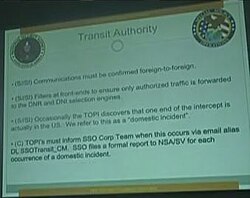Scope of the program
The program comprises cooperation with a "key corporate partner", which was identified on October 23, 2013 by The Washington Post —quoting NSA historian Matthew Aid—as Verizon. [2] This was confirmed by a joint report by Pro Publica and The New York Times from August 15, 2015. [3]
STORMBREW is an umbrella program involving surveillance of telecommunications. It falls under the category of "Upstream collection", meaning that data is pulled directly from fiber-optic cables and top-level communications infrastructure, which allows access to very high volumes of data. A first pre-selection is done by the telecommunication providers themselves, who select the Internet traffic that most likely contains foreign communications. Then the data is passed on to the NSA, where a second selection is made by briefly copying the traffic and filtering it by using so-called "strong selectors" like phone numbers, e-mail or IP addresses of people and organizations in which NSA is interested. [4]
A map shows that the collection is done entirely within the United States. This corporate partner has servers in Washington, California, Texas, Florida, and in or around New York, Virginia, and Pennsylvania. [5] [6] [7]
This page is based on this
Wikipedia article Text is available under the
CC BY-SA 4.0 license; additional terms may apply.
Images, videos and audio are available under their respective licenses.









